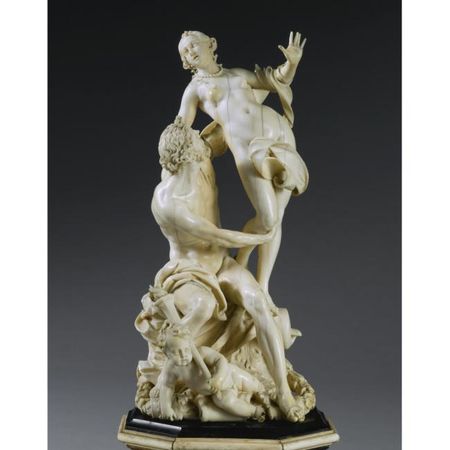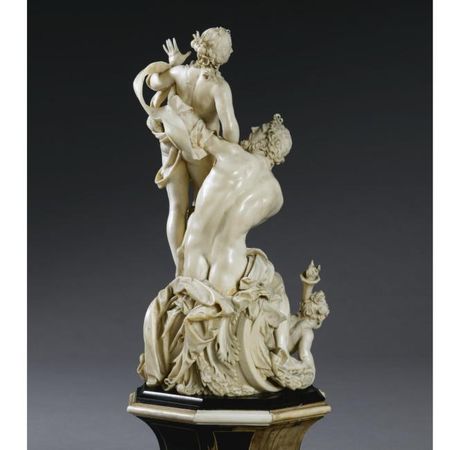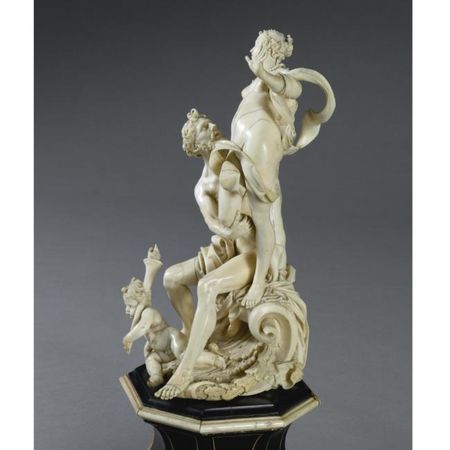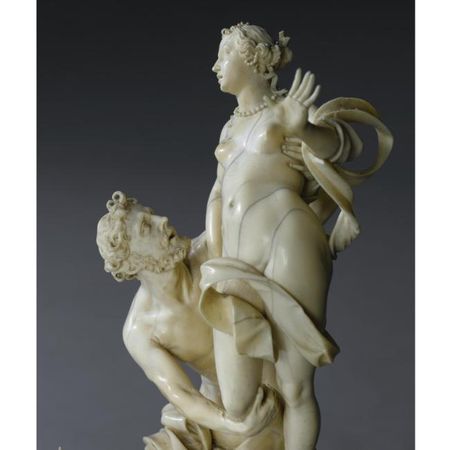An Austrian ivory group of Pluto and Proserpina, attributed to Matthias Steinl (circa 1644-1727), circa 1700
An Austrian ivory group of Pluto and Proserpina, attributed to Matthias Steinl (circa 1644-1727), circa 1700. photo Sotheby's
upon original ivory-inlaid and ebony-veneered socle. height without socle 10 1/4 in.; 26 cm. Est. 120,000—150,000 USD. Lot Sold 1,202,500 USD
PROVENANCE: Baron Alphonse de Rothschild (1878-1942), Vienna
Seized from the above and allocated for the Kunstmuseum Linz, recovered in crate no. 2 ,1938/9 (reference AR 2608)
Restituted to the Austrian government, Kremsmünster depot, 1947
Restituted from the above to Baroness Clarice de Rothschild, New York, 1947
LITERATURE AND REFERENCES: F. Schestag, Katalog der Kunstsammlung des Freiherrn Anselm von Rothschild in Wein, vol. I, Vienna, 1866, p. 14, no. 92
C. Theuerkauff, 'Baroque Ivories from the collection of Anselm Salomon von Rothschild in Vienna', in Apollo, v. 157, February 2003, pp. 15-25, no. 12 (illus.)
S. Lillie, Was einmal war, Vienna, 2003, p. 1002ff (inv. no. 2608
RELATED LITERATURE: C. Theuerkauff, 'Una statuetta di Tritone a Londra: Opera Giovanile di Matthias Steinl?', in Antichita Viva, xi/5 (1972), pp. 49-52
L. Pühringer-Zwanowetz, Matthias Steinl, Vienna, 1996
S. Hagg, Kaiserlisches Elfenbein: Matthias Steinl (1643/44-1727) in der kunstkammer des Kunsthistorisches museums, Vienna, 2007
This elegantly composed and beautifully carved ivory group incorporates the figural types, physiognomy, mannerist proportions and billowing swathes of drapery that distinguish the work of the Austrian Baroque sculptor Matthias Steinl.
Three magnificent ivory equestrian statuettes by Steinl of Kaisers Leopold I, Karl VI, and Joseph I, dating to circa 1693, are in the Kunsthistorisches Museum, Vienna (Haag, op. cit, pp. 135-143). These feature several of the motifs seen in the present ivory, most noticeably in the treatment of the figures and the carving of the details such as the hair interwoven with pearls. The contrast of sharp-edged and soft forms, and the sculptor's ability to create space with the constant, varied movements of his figures also bear close affinity to the virtuoso sculptor's other documented carvings such as his ivory group of the elements, Water and Air, also in Vienna (Theuerkauff 1972, op. cit., nos. 5 and 6). The similarity in the proportions and positions of the figures as well as the use of ornamental scrolling acanthus further supports this attribution.
Theuerkauff illustrated the present sculpture, the location of which was at the time unknown, in his article on the collection of Anselm Salomon von Rothschild in 2003 (op. cit., no. 10), together with another group of Neptune Abducting Thetis. Though the Neptune group is perhaps by a different hand, it was shown on an identical waisted, ebony-veneered socle.
Pluto, struck by Cupid's arrow and suddenly ignited with love for Proserpina, daughter of Ceres, seized his new love and carried her to the underworld. At Pluto's feet the figure of Amor carries a torch leading the way, and represents Love illuminating the darkness.
Sotheby's. Important Old Master Paintings and Sculpture. 28 Jan 10. New York www.sothebys.com

/https%3A%2F%2Fprofilepics.canalblog.com%2Fprofilepics%2F1%2F0%2F100183.jpg)






/http%3A%2F%2Fstorage.canalblog.com%2F01%2F25%2F119589%2F66468802_p.jpg)
/http%3A%2F%2Fstorage.canalblog.com%2F34%2F40%2F577050%2F65733247_o.jpg)
/http%3A%2F%2Fstorage.canalblog.com%2F23%2F55%2F119589%2F65801169_p.jpg)
/http%3A%2F%2Fstorage.canalblog.com%2F40%2F54%2F119589%2F65372473_p.jpg)